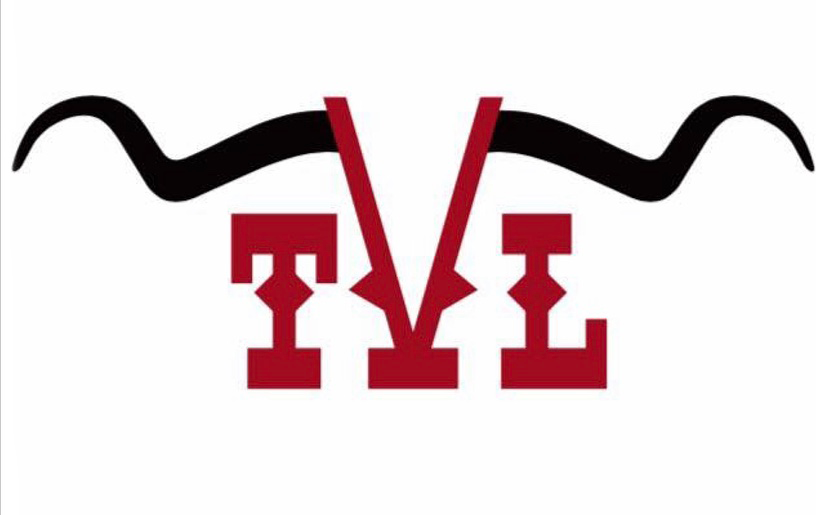New to TVLA?
Start here if you’re new to TVLA or buying and selling livestock in general!
Treasure Valley Livestock Map
Click or tap on the red areas for an interactive map of our sale yard.
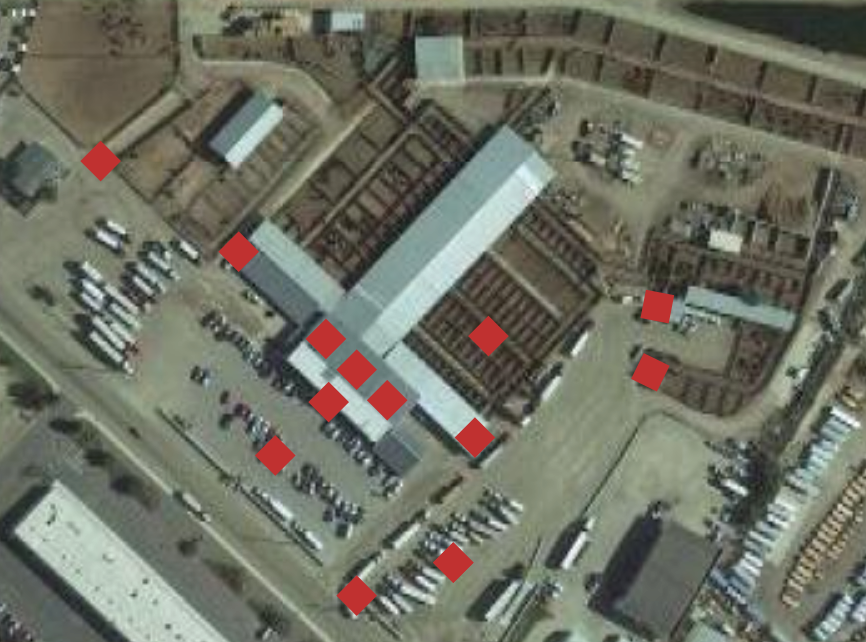
Load Out

Pick up your cattle here after you've settled up in the office! Pull under the overhang with your paperwork ready and someone will assist you.
If you're dropping off very young baby calves, you will unload them here for Friday sales.
Drop Off for Cattle

Pull in this area to drop off cattle for Friday and Special sales.
Sale Ring

Head in through the front door and straight back to find the ring.
Office

Get your buyer's number, check, brand inspection and more in the office.
Cattlemen's Cafe

Get breakfast and lunch at the in-house Cattlemen's Cafe!
Parking for Vehicles Without Trailers

Parking for vehicles without trailers.
Trailer Parking

Parking for trailers for all sales.
Trailer Line (Fridays)

This line can get pretty long, but it's the one for dropping off cattle for Friday and Special Sales. Please do your best to not block traffic on Chicago St.
Drop Off--Small Animal

Drop off area for Saturday small animal sales.
Pens

Pens are off limits to non-employees.
Trailer Line (Saturdays)

Enter through the gate to the west of the drop off area to drop off livestock for the Saturday goat, sheep, and pig sales.
Front Entrance

Semi Truck Unloading

How to Sell
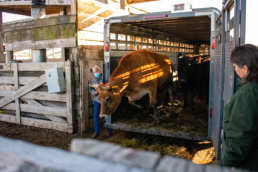
Friday & Special Sales
Drop Off: You can drop cattle off at any time before the sale between 8 am and 5 pm. We’re open until 7:30 pm the night before sales and available for drop off as early as 7:30 the morning of. If you need to drop off after hours, please call the office.
Head to the drop off (see map). You’ll pull forward under the overhang until the gate can close behind your trailer. Someone will meet you to check in your cattle. Please wait to unload them! Someone will need to set up the correct pen.
You’ll need to bring a bill of sale from when you purchased the cattle if they do not have your brand.
Baby Calves: Baby calves that are too small to travel through the pens should be dropped off in the load out area. See map.
Selling: Friday sales sell in the following order:
- Feeder Calves
- Baby Calves
- Stock Cows
- Pairs
- Butcher Cattle
It’s a little hard to predict exactly when your cattle will sell, but you’re welcome to inquire at the office about how many head are checked in.
Getting your check: You can receive payment shortly after your cattle sell. When you check in, you’ll specify whether you’d like to pick up your check or have it mailed to you.
Fees, commission, and other costs:
- Commission: the charge the sale yard takes for the service of selling your cattle. 2.5% of the selling price.
- Beef Council: a fee assessed by the Idaho Beef Council called the Beef Checkoff Program. This funds help support marketing, research and education to support the Idaho cattle market. $1.50/head.
- Feed: the cost of feeding your cattle between when you drop them off and when they sell. $2/head/per day for cattle less than 700 lbs and $3/day for cattle > 700 lbs.
- Brand Inspection: the cost of the Idaho State Brand Inspection that is required when ownership of cattle changes. $1.46
- Insurance: the cost of insuring the animals while they are at the sale yard. $0.20/head
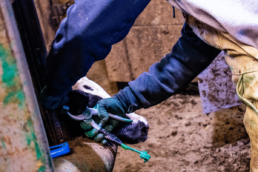
On-site veterinarian available for:
- Preg checks
- Bangs vaccine
- Other vaccines
- and other options. Call the office to schedule veterinary services on cattle you’re purchasing or selling.
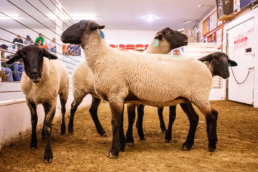
Saturday Sales
Drop Off: Drop off opens at 7:30 am on Saturdays. If you need to drop off on Friday, please wait until our Friday sale is over, usually around 5 pm.
Head to the drop off (see map) by pulling in at the furthest west entrance. You’ll go through the green gate and around the barn until you come to the unloading area. Someone will meet you to check in your cattle. Please wait to unload them! Someone will need to set up the correct pen.
To sell calves, you’ll need to bring a bill of sale from when you purchased the animal if they don’t have your brand.
All sheep and goats, except wethers, are required to have scrapie tags. See dictionary. Scrapie tags are available for $10 at the sale, but we recommend obtaining them ahead of time by calling (208) 373-1626
Selling: Saturday sales sell in the following order:
- Calves
- Pigs
- Lambs and Sheep
- Goats
It’s a little hard to predict exactly when your animals will sell, but you’re welcome to inquire at the office about how many head are checked in.
Getting your check: You can receive payment shortly after your animals sell. When you check in, you’ll specify whether you’d like to pick up your check or have it mailed to you.
Feed: $1/ day for pigs, sheep, and goats. $2/day for calves
Brand inspection (calves): $1.46
Insurance: $0.20 (calves), $0.12 (pigs, sheep, and goats)
Commission (calves): 2.5%
Commission (pigs): starting at $5.00
Commission (sheep): $5.00
Commission (goats): starting at $6.00
How to Buy
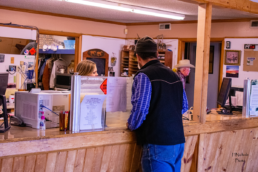
Step 1: Head to the office to register for your bidder’s number and leave a form of payment.
When you get to the office, you can also specify if you’d like multiple order numbers that will separate your animals into different bunches based on type. This is typical for buyers that purchase large numbers. An example would be organizing them by weight class or sex, such as Bidder #291 on heifers. Most people buying small numbers of animals don’t worry about specifying orders.
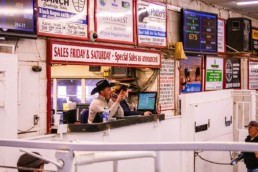
Step 2: Place your bids! Head into the sale ring and wait for the animals you’re looking for. Some will sell in large bunches and some will sell as singles. The auctioneer will share any details he knows about the animals. Raise your hand and catch the auctioneer’s eye to bid.
Remember: you’re buying what’s in the ring. If there’s 5 head, you’re bidding on all five of them!
You can ask questions in the ring! Make sure you’re clear on what you’re buying before you bid.
Step 3: Check out. You’ll head back to the office to settle up. You’ll get your receipt and your load out ticket at the counter where you got your buyer’s number.
After you’re done at the office, head to the brand table to get the brand inspection paperwork.

Step 4: Load out. Pull into the load out gate. You’ll pull far enough ahead that your trailer door can open and the gate can close behind it. Have your yellow load out paper ready and someone will be there shortly to bring your animals.
Please be patient if you’re loading out while the sale is still going! We do our best to get someone to you quickly, but our employees are working on keeping the sale going at the same time.
Useful Markings when Buying Cows
When cows are brought in to the sale yard, they are marked with paint sticks to tell you their age, if they’re bred, and more. If you’re looking to buy cows for breeding purposes, it can be very useful to understand what these markings mean!

The number on the cow’s hip tells you how many months bred she is.
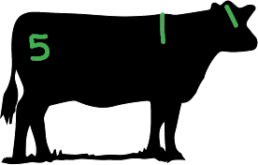
A line on the forehead means heifer. This heifer is 5 months pregnant.
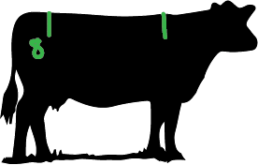
The further back the line, the older the cow. This cow is older, but still solid mouthed (see definitions).
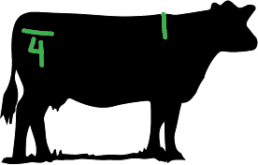
A line above the preg number means the cow is broken mouthed.
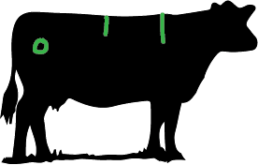
An O instead of a number means the cow is open, or not bred. This is a younger cow that is not pregnant.
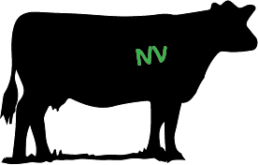
Cows with an NV have not been Bangs vaccinated. The NV stands for “No Vacc.” You’ll also occasionally see cows marked with AV, meaning they were adult vaccinated.
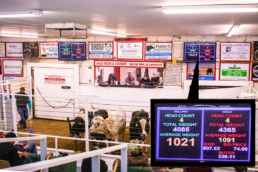
In the Ring
The sale ring is a large scale that is re-calibrated frequently throughout the sale to account for manure, if the ringmen switch, and more.
The boards on either side of the auction block show what’s currently selling as well as information about the previous lot.
In this lot, there’s four head weighing a total of 4085 and averaging 1021 each. The previous lot was fairly similar. They sold for $74.00/CWT (see bid price on the sign), bringing $807.52 each (see $/HD). CWT is price per hundred pounds.
The auctioneer’s chant will tell you the current bid. Chants contain the current bid price and what the auctioneer is asking for. The auctioneer will also say whether the animals are selling by weight or by the head. Learn more about the auctioneer’s chant.
Words You Should Know
Adult Vaccs: Cows that are Bangs vaccinated after one year of age. These cattle cannot be shipped to Nevada.
Bangs Vaccine: A vaccine for Brucellosis required in all female cattle unless they are going to a state-approved feedlot. This vaccine must be administered by a veterinarian. Cattle receive a clip in their left ears as well as a tattoo inside the ear when they get the vaccine. All female cattle under a year of age going through our sale will receive a Bangs vaccination from our on-site vet at the seller’s expense. See No-Vacc
Broken Mouth: A cow that’s lost some of her lower teeth, meaning she’s an older cow.
Butcher Cows: Cows and bulls no longer fit for breeding or milking sold for slaughter.
Buyer Number (or Bidder Number): What you need to bid on an animal! Visit the office to register for a buyer number. When you win a bid on an animal or bunch, the auctioneer will ask your buyer’s number and those animals will be put in a pen based on your number.
By the Head: Animals sold by the individual, rather than by weight.
Commission: The percentage the sale yard takes from the selling price for the service of selling the animals. This is taken from the selling amount, not paid by the buyer.
CWT: Price per hundredweight. If you see $153.5 (CWT), that means the animal brought $1.535/pound or $153.5/hundred pounds.
Feeders: Weaned calves of various weights–called feeders because they’re ready to be fed and finished. Sold in Friday sales and at fall and winter monthly Feeder Sales.
Market: Cattle, sheep, goats, and hogs are considered a commodity, so “The Market” refers to the current commodity market. Just like the stock market, prices fluctuate and are determined by supply, demand, recent prices, and predictions of future prices. This article can help you understand how to read market reports. You can view our most recent market reports here.
No-Vacc: A term for cows over 12 months of age that have not received a Bangs vaccine. Cattle that sell no-vacc are sold for slaughter only, not breeding purposes.
Preg check: Checking if a cow is pregnant. You’ll see cows come into the ring with a number on their hips–this tells you how many months bred she is. An O means open, or not pregnant.
Scrapie Tags: Scrapie is a chronic, fatal disease of the nervous system in sheep and goats. As part of the USDA’s Scrapie eradication program, all sheep and goats that are reproductively intact must have Scrapie tags when sold, similar to Bangs tags in cattle.
Solid Mouth: A cow with all of her teeth intact, meaning she is a younger to middle aged cow.
Special Sale: Extra sales other than our usual Friday and Saturday sales. These are usually feeder calves, but can also be stock cows.
Stock Cows: Bred cows, usually of beef breeds. Sold on Fridays and at an annual Stock Cow Sale.
